You’ll need parametric CAD software like 3Design ($6,950) or budget-friendly Rhinoceros ($995) with Grasshopper3D plugins to create kinetic jewelry with moving components. Focus on establishing precise tolerances for articulated joints and mechanical connections that maintain structural integrity while enabling smooth movement. Use advanced sculpting tools in ZBrush for organic forms, then validate your designs through motion simulation features before 3D printing prototypes. Master dynamic lighting and specialized rendering engines like LUXCORE to showcase how your pieces interact with light and demonstrate their full kinetic potential.
Understanding Parametric Design Principles for Movement Integration
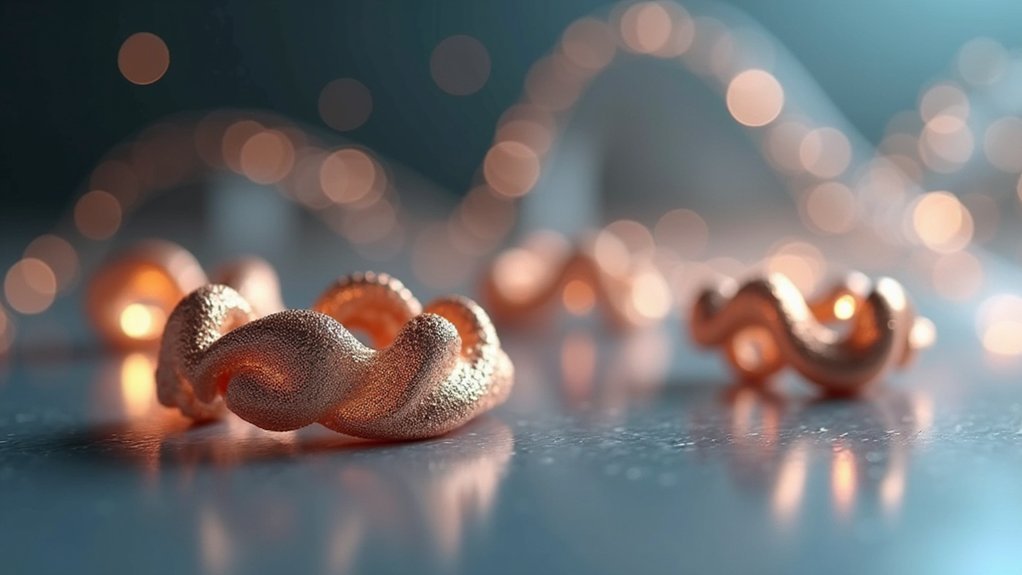
How can jewelry designers create pieces that move and adapt while maintaining structural integrity? You’ll find the answer in parametric design principles, which enable flexible jewelry models that respond to real-time changes in dimensions and shapes.
When you use advanced CAD tools with parametric modeling capabilities, you’re establishing relationships between components that allow easy adjustments without restarting your design process.
You can integrate movement through constraints and parameters, creating complex articulated parts or adjustable settings that function dynamically.
Advanced CAD tools include motion simulation features, letting you visualize how your piece interacts with the wearer before production.
Software Selection for Kinetic Jewelry Applications
Three essential factors determine your success when selecting CAD software for kinetic jewelry applications: parametric modeling capabilities, motion simulation features, and precision control systems.
You’ll want to prioritize advanced parametric modeling tools like 3Design ($6,950) and Jewelry CAD Dream ($5,850), which excel at creating intricate moving parts and mechanisms. These programs offer intuitive sculpting features and automatic gemstone insertion essential for dynamic designs.
For budget-conscious designers, Rhinoceros ($995) delivers complex geometry capabilities perfect for kinetic jewelry. You can enhance its functionality by incorporating Grasshopper3D plugins for parametric adjustments, ensuring precise movement control.
If you’re experimenting with kinetic designs, Blender provides free access to diverse modeling techniques and procedural jewelry creation flexibility, making it invaluable for testing innovative concepts.
Modeling Articulated Components and Mechanical Joints
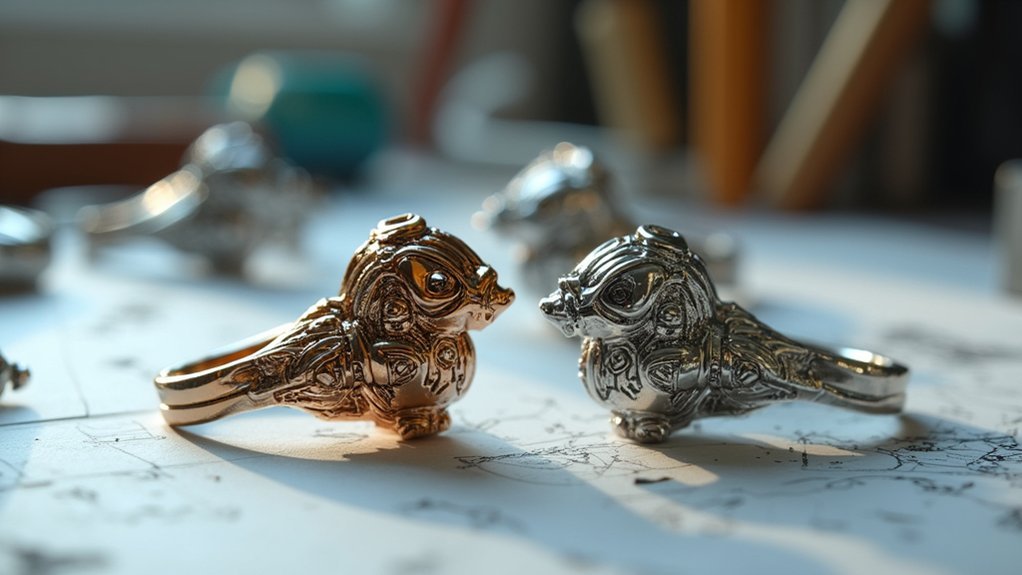
Precision becomes your greatest ally when modeling articulated components for kinetic jewelry, as even microscopic variations can transform smooth movement into frustrating friction.
You’ll need to establish precise tolerances that allow seamless motion while maintaining structural integrity throughout your design.
Your jewelry CAD software’s parametric modeling features enable you to create adjustable mechanical joints that adapt to different designs effortlessly.
Focus on designing interlocking hinge mechanisms with proportional sizing to guarantee durability under regular wear.
Leverage your CAD modeling software’s simulation tools to visualize range of motion before production. This prevents costly design errors and validates functionality early in the process.
Always prototype your articulated components through 3D printing to test real-world performance, allowing you to refine tolerances and assembly methods before final manufacturing.
Advanced Sculpting Techniques for Organic Forms
While mechanical joints demand mathematical precision, organic forms in jewelry design flourish through fluid sculpting techniques that capture nature’s inherent irregularities and flowing beauty.
You’ll find that advanced sculpting techniques in ZBrush enable intricate organic shapes that mimic natural elements through detailed textures and forms.
Dynamic subdivision becomes your key tool, allowing you to add complexity without compromising mesh integrity.
Dynamic subdivision preserves mesh quality while enabling intricate detail addition, making it essential for complex organic jewelry modeling workflows.
IMM brushes streamline jewelry creation by incorporating pre-made organic components, accelerating design iterations considerably.
You can rapidly introduce intricate patterns using alpha and texture maps during sculpting, enhancing surface qualities instantly.
Mastering these sculpting tools transforms your workflow, increasing model quality while revealing creative possibilities.
You’ll create unique, bespoke pieces that distinguish your jewelry creation in competitive markets through nature-inspired organic shapes.
Creating Dynamic Textures and Surface Treatments
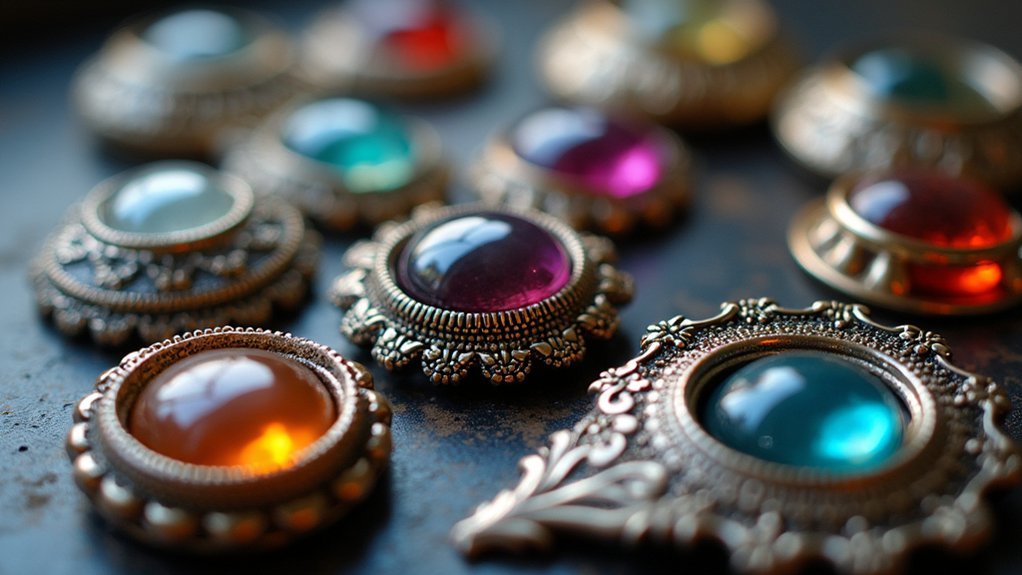
Beyond sculpting organic forms, you’ll discover that dynamic textures and surface treatments breathe life into your jewelry designs through sophisticated digital techniques.
Advanced CAD programs like ZBrush offer powerful sculpting tools that create intricate surface details impossible with traditional methods. You’ll harness alpha and texture maps to rapidly apply complex patterns, while dynamic subdivision lets you add detail layers without compromising your underlying mesh structure.
Experimenting with engraving and embossing techniques adds unique character that appeals to diverse aesthetic preferences.
When you combine procedural techniques with manual sculpting in programs like Blender, you’ll achieve versatile, innovative textures that enhance visual appeal and provide narrative quality to your pieces.
These sophisticated surface treatments transform ordinary designs into compelling, story-driven jewelry.
Animation Workflows for Design Validation
As your jewelry designs shift from static models to dynamic presentations, animation workflows become essential tools for validating both functional and aesthetic elements before production.
You’ll leverage software like Blender and ZBrush to create dynamic animations that simulate light interaction and movement, enabling better aesthetic decisions. Through keyframe animation techniques, you can demonstrate intricate mechanisms like clasps and adjustable components, revealing insights into design integrity and user experience.
These computer-aided design (CAD) animation workflows allow you to generate compelling client presentations, showcasing piece features while encouraging feedback for refinements.
Real-time rendering provides immediate visual feedback during animation, facilitating quick iterations based on client preferences or functional requirements. This integration of design validation through animation guarantees accurate fit and performance testing before costly production begins.
Prototyping Strategies Using 3D Printing Technologies
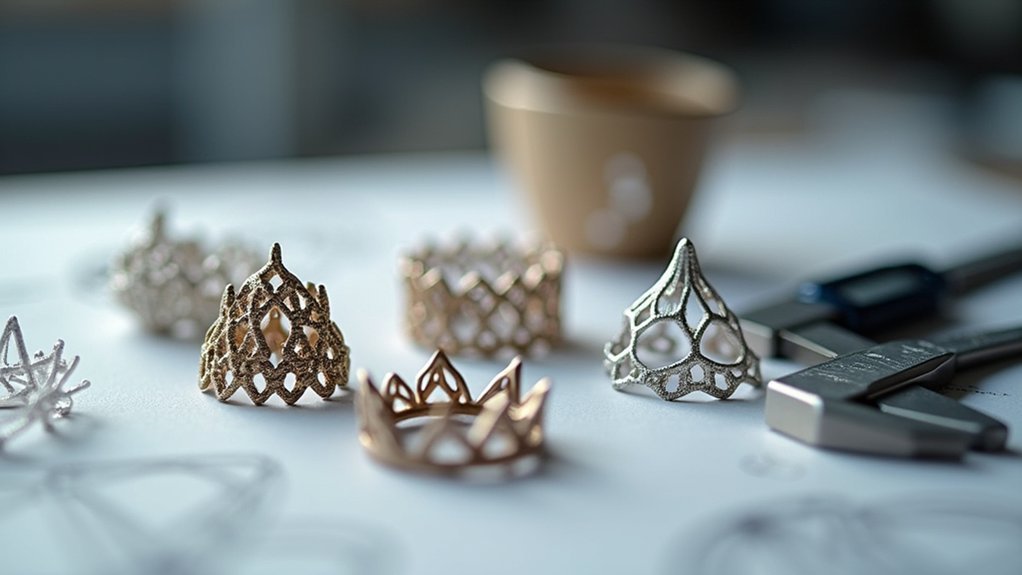
When shifting from animation validation to tangible testing, 3D printing technologies revolutionize how you’ll approach jewelry prototyping by enabling rapid iteration cycles that compress weeks of traditional model-making into hours.
You’ll leverage stereolithography (SLA) and fused deposition modeling (FDM) methods to achieve exceptional detail and precision with various materials including resin and plastic.
Your prototypes will let you evaluate fit, comfort, and aesthetic appeal before production, ensuring customer satisfaction.
3D prototypes enable comprehensive evaluation of fit, comfort, and aesthetics, guaranteeing satisfied customers before final production begins.
You’ll create intricate designs with complex geometries that traditional manufacturing can’t achieve. This prototyping approach enhances customer engagement since clients can physically interact with models before committing to final designs.
Through strategic 3D printing implementation, you’ll transform your jewelry design workflow from conceptual validation to tangible verification seamlessly.
Rendering Methods for Showcasing Motion and Materials
You’ll need to master dynamic lighting techniques that utilize HDR light sources to create realistic reflections and enhance gemstone brilliance in your renders.
Your material simulation methods should focus on accurate dispersion effects, which you can achieve through specialized rendering engines like LUXCORE or OCTANE despite their slower processing times.
You can greatly boost client engagement by incorporating animation techniques that showcase your jewelry’s movement and demonstrate how light interacts with different materials and textures.
Dynamic Lighting Techniques
While static jewelry renderings showcase basic design elements, dynamic lighting techniques transform your 3D models into compelling visual narratives that capture the true essence of precious metals and gemstones.
You’ll achieve realistic reflections and shadows by implementing HDR lighting setups that enhance your jewelry designs’ visual appeal. Combine area lights with key lighting to highlight intricate gemstone details and textures in your rendering and animation projects.
Choose Cycles or LuxCore render engines for superior quality—LuxCore delivers exceptional dispersion effects despite longer processing times.
You’ll create authentic lighting conditions by employing multiple light sources that showcase material properties effectively. Experiment with light intensity and color temperature adjustments to evoke different atmospheres and emotional responses, allowing your jewelry pieces to convey various styles and moods through sophisticated illumination control.
Material Simulation Methods
Advanced material simulation transforms static jewelry models into dynamic showcases that reveal how precious metals flow and gemstones interact with light during movement.
You’ll achieve photorealistic results by implementing advanced rendering engines like Cycles, LuxCore, or Octane in your CAD workflow. These material simulation methods accurately render reflections, refractions, and light dispersion across gemstones and metals.
HDR lighting elevates your renders by mimicking natural light conditions, exposing intricate details that static lighting can’t capture.
You can employ dynamic simulations to demonstrate how chains flex or clasps engage during actual use. Procedural textures and material maps in ZBrush or Blender let you rapidly apply complex surface details to enhance authenticity.
Environment maps and light probes create immersive presentations that captivate clients and showcase your jewelry’s true potential.
Frequently Asked Questions
Is Fusion 360 Good for Jewelry Design?
You’ll find Fusion 360 excellent for jewelry design. It’s user-friendly, offers parametric modeling for easy modifications, handles complex geometries, includes stress testing tools, and it’s free for students and startups.
What Is 3D Jewelry Design?
You’ll use computer-aided design software to create precise digital jewelry models. You can visualize complex shapes, add intricate textures, and rapidly prototype designs. It’s revolutionizing how you’ll craft unique, customizable pieces with enhanced storytelling capabilities.
How to Design Jewelry for Beginners Step by Step?
Start with sketching your concept on paper, then choose simple shapes like rings or pendants. Use beginner-friendly software like TinkerCAD, learn basic tools, add details gradually, and create prototypes for testing.
How Much Does a Jewelry CAD Cost?
You’ll find jewelry CAD software costs vary widely, from free options like Tinkercad to premium solutions costing $7,000. Mid-range choices include ZBrush at $895 or Fusion 360 at $495 annually.
In Summary
You’ve mastered the essential techniques for creating dynamic jewelry that moves and captivates. By combining parametric design principles with advanced sculpting methods, you’re equipped to model complex articulated components and mechanical joints. You can now select appropriate software, create stunning textures, validate designs through animation, and bring concepts to life using 3D printing. These skills will transform your static jewelry designs into extraordinary kinetic masterpieces that engage and delight wearers.

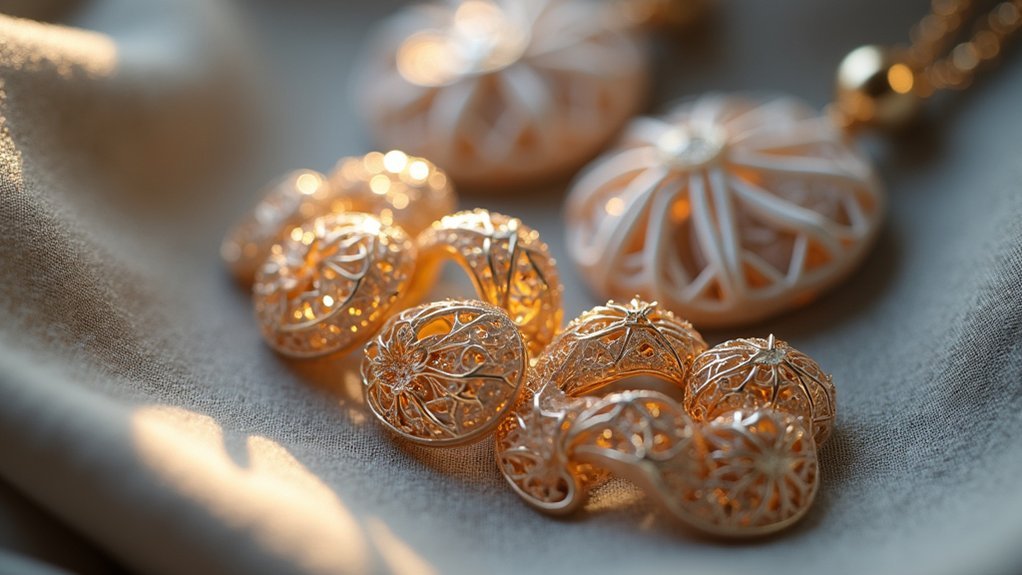



Leave a Reply